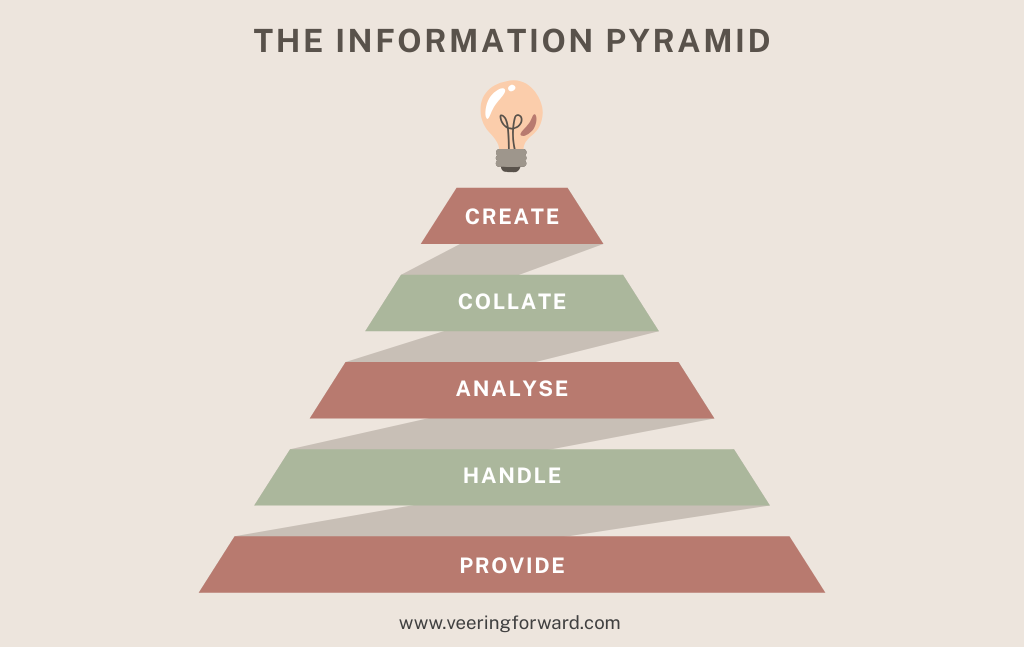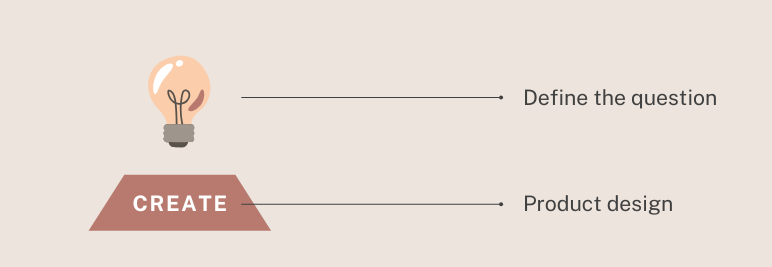Will AI take my job? Part 3 - The information pyramid
Not every knowledge worker will be replaced by AI, but some are more vulnerable. The Information Pyramid ranks knowledge work from most to least vulnerable to AI.

In Part 2 of the "Will AI take my job?" series, I wrote about a paper from Microsoft Research on "occupational implications of generative AI". One of the insights of the paper is that generative AI tools such as LLMs are more suited for "knowledge work". I've been thinking about that ever since.
"Knowledge work" is a broad term - arguably every white-collar worker is a knowledge worker. No one is suggesting that every white-collar job will be replaced by AI (yet), but some role types are more vulnerable than others.
Based on my experience with LLMs (both from personal use and from implementing AI solutions at Day Job), I came up with The Information Pyramid. Let's go through each layer from bottom to top.

Provide: A lot of knowledge workers are in the business of providing information to others. An example is call centre staff answering customer inquiries. Most of us have interacted with online chatbots on company websites or apps. In the early days, they struggled with anything beyond basic questions, but their performance has improved, and there were times where the chatbots were able to resolve my queries without the need for me to talk to or message a staff member.
AI chatbots will become more sophisticated with their understanding of complex requests, and as they become better integrated with company data. Jobs primarily related to providing existing information to customers (internal and external) are at the highest risk of being impacted by AI.
Handle: There are myriad roles in operation teams where workers are handling information. They may be processing customer applications or reviewing bug fix and feature requests. A lot of simple information handling is already automated, but AI will turbocharge the process. LLMs' ability to interpret natural text will allow customers to fully articulate their requirements, and vastly reduce the need for staff to fill in information gaps. In the (near) future, companies may remove application and request forms altogether - through "conversations" with chatbots, applications and requests will be created in the backend with information structured to support full automation.

Analyse/Collate: This may be controversial, but I'm putting analytics below collation in the pyramid. As the capabilities of LLMs improve, analysis of information that are already in a company's ecosystem will become increasingly commoditised, and differentiation will shift towards the ability to collate quality information for the LLMs to consume as input, context, and training data.
In the job examples I provided above, the nature of reporting work will change - staff may not be replaced altogether, but (1) many teams will be able to generate their own reporting effectively, and (2) businesses will expect reporting teams to leverage AI tools and work at a higher velocity.
There are caveats. Manual reporting is often required because a company's data sources are not integrated, or they require bespoke adjustments before analysis. Also, some of the flaws of LLMs such as hallucination have to be addressed before companies can fully automate analytics.
As for collation - the example I used is customer research. Understanding what customers need and want are vital. Some insights can be gleaned through data analytics, but qualitative customer research is also important. Until customers and users are willing to interact with AI researchers, and said AI researchers can accurately capture nuances such as body language and tone of voice, human researchers will still be in demand.

Create (with): This is not about creation in the pure sense - I'm definitely not talking about TikTok content creators. Rather, I'm referring to knowledge work where a worker uses information and analytics in problem solving and decision making.
AI will get better at work like this as well. For instance, you can already provide customer data and other input and prompt an LLM to come up with a marketing campaign. Meta is moving towards AI generated advertising - i.e. their customers can state their advertising objectives and Meta will use AI to generate creative assets.
However, a company's information ecosystem doesn't have access to all data, and problem solving and decision making involve more than information and knowledge. Allocation of finite resources and management of conflicting business objectives - including the people involved - will require deft touches that LLMs cannot handle in isolation (for now).
💡: I used an image at the top of The Information Pyramid - a light bulb, but it can also be a question mark. So far, I talked about different ways knowledge workers can interact with information - but at the top, information and knowledge are no longer the primary driver.
Innovation and transformation hinge on the ability to see something that others can't, and to me, it starts with asking the right questions. I can talk about industry-redefining examples such as Netflix, Uber and Airbnb, but 💡 doesn't have to be about a brand new business, or even about senior management.
A team may own an existing process with various customer pain points. The team can choose to use data analytics, research, and other tools (AI enabled or not) to understand these pain points and find ways to remove or mitigate them, but pain points are often the symptoms and not the underlying cause of an issue. Instead of asking "how can we stop [pain point] from happening", the team may instead ask "what are the objectives of the existing process, and can we achieve the same end outcome in a different and better way?"
To me - being curious and asking probing questions, reframing an issue at hand, and tackling it from different perspectives sit at the top of The Information Pyramid.
Knowledge workers who are able to effectively leverage the information and insights from the different layers of the pyramid, including AI and other technology, and ask the right questions will have a lot less to fear about the march of AI into their industry and company.
Why don't you ...
Think about the work you do and see how much of it land in each layer of The Information Pyramid.
Programming note
I did not write last week because I was under the weather again, and I've been managing two roles at Day Job.
Thank you for understanding.
Vee





